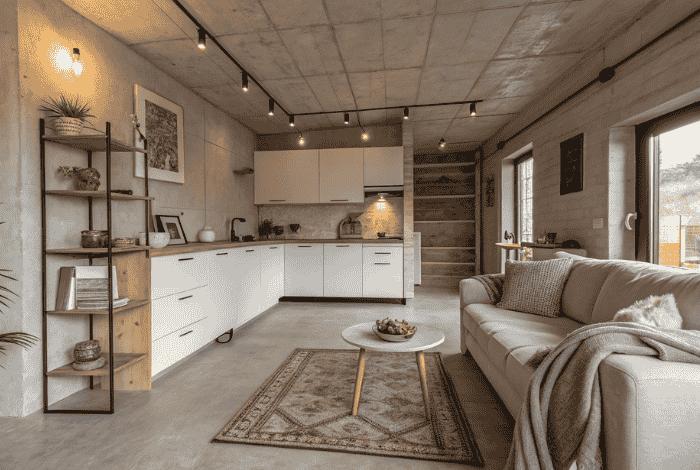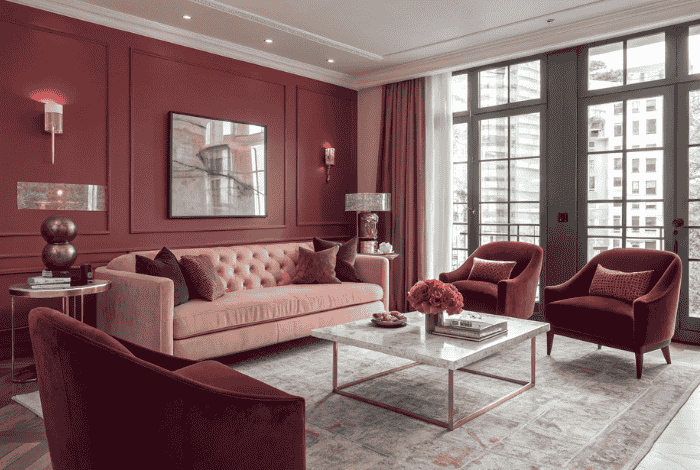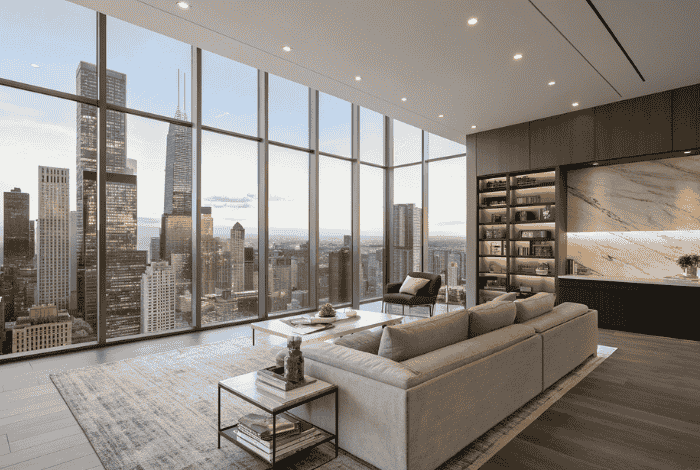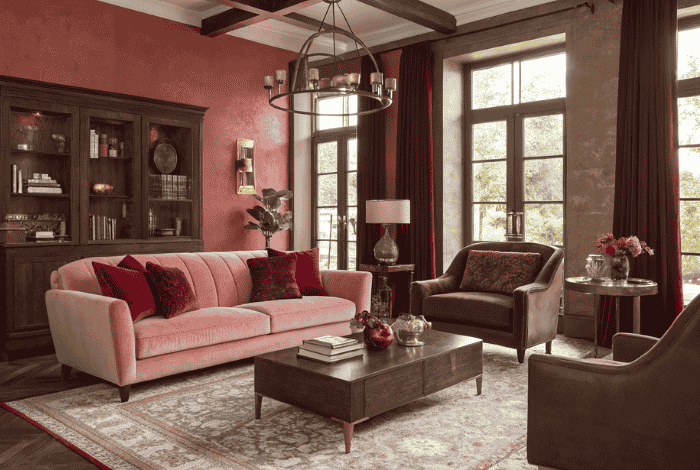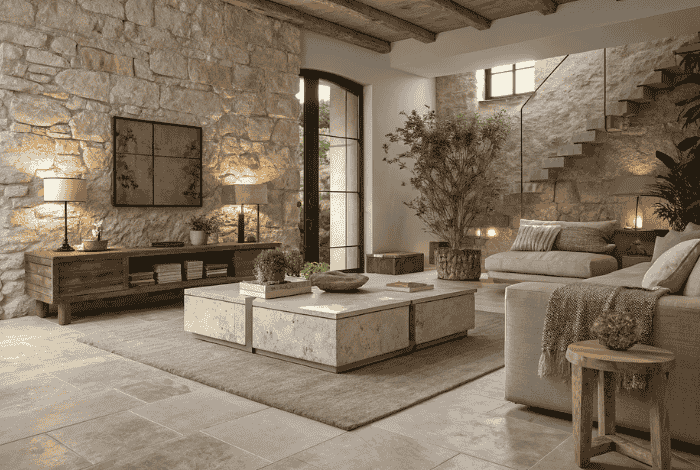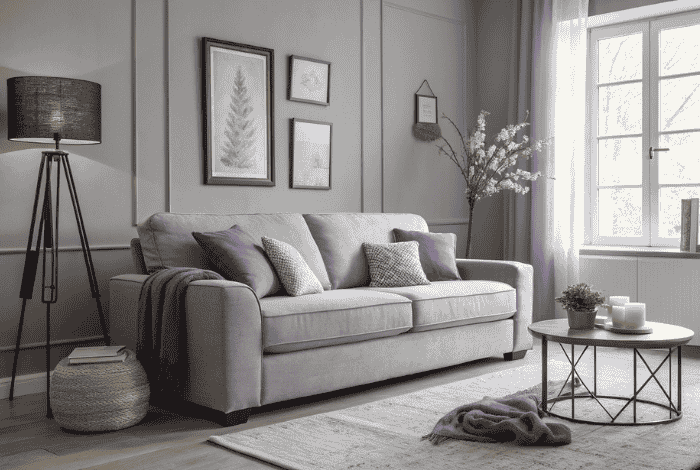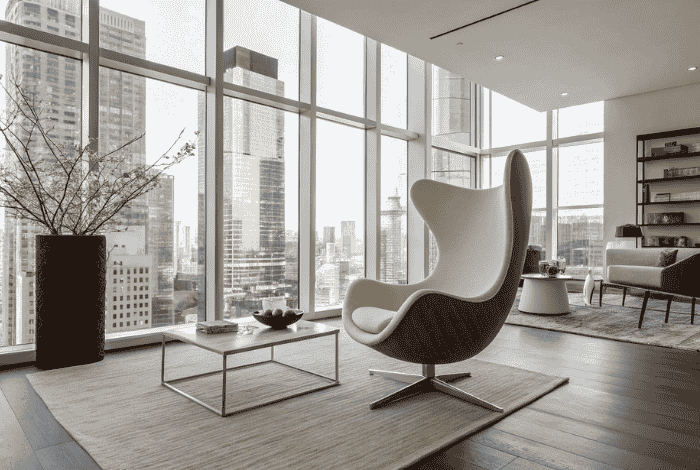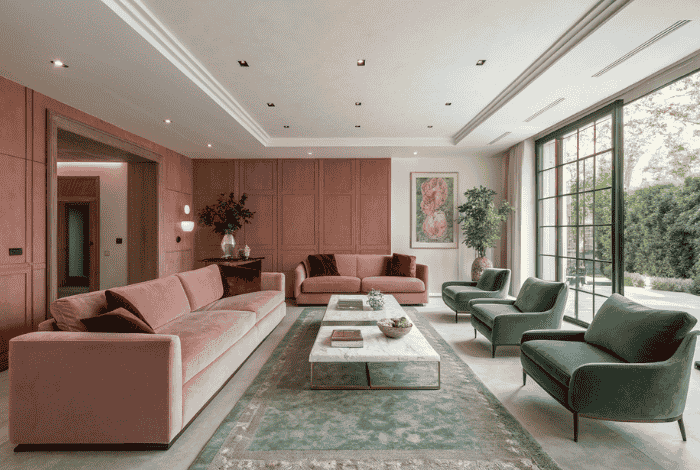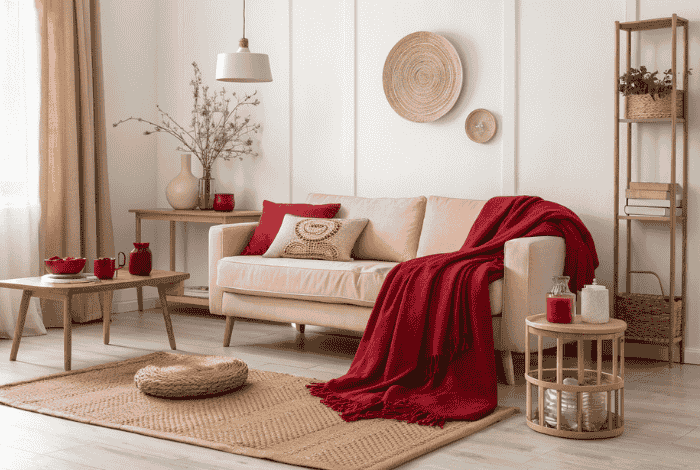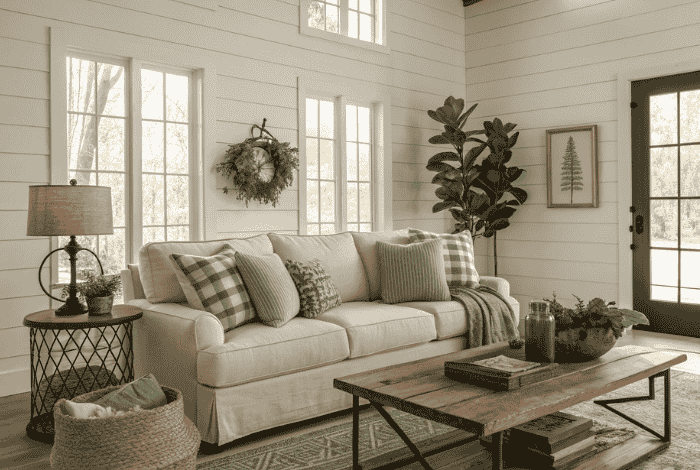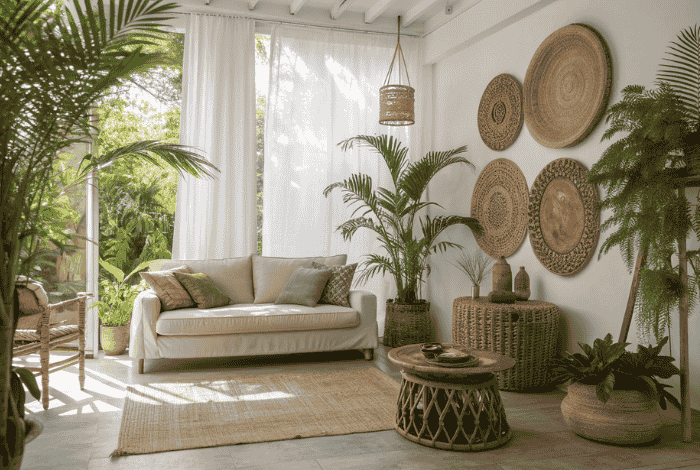Here’s a trick I keep using when a kitchen feels stuck: two tone kitchen cabinets. Sounds simple, but the right pairing makes guests stop and stare. I tested combos for years, some wins, a few flops, and today I’m sharing the sets that actually work and feel personal.
Quick story. One night I was scrolling Instagram way too late and saved about 16+ kitchens in ten minutes. I spilled tea on my shirt, my cat stepped on the save button, and that is honestly how I found half of these designs. Chaos, but good chaos. Anyway, I DMed a cabinet maker at 1 a.m., he replied with a paint code, and I knew I had to pull this post together for you.
Blush Peach + Clean White Island
This airy kitchen is soft and happy. The peach cabinetry wraps the room like a warm sunrise, while the ribbed white island keeps the palette crisp. Arched door details add a little drama but still friendly. I’d pick this if you want gentle color that never screams.
- Pair with: Brushed brass faucet, simple round knobs, white quartz top.
- Best for: Small or mid kitchens that need brightness.
- Pro tip: Match wall color to the lightest tint of the peach so doors and walls blend, making the room feel bigger.
Navy Lowers + Light Gray Uppers + Wood Tops
Navy on the base cabinets grounds the space. Gray uppers keep it calm and not heavy. Butcher block counters bring warmth, and in late day sun the room looks golden. I love this in rentals or townhomes where you want polish but still cozy.
- Pair with: Unlacquered brass cup pulls, off-white subway tile, woven baskets.
- Best for: Narrow galley kitchens.
- Pro tip: Use a satin sheen on navy to hide scuffs; kids and pets will test you.
Jet Black Frame + Natural Oak Uppers
Moody but not gloomy. Black housing around a run of natural oak doors makes the grain pop, almost like a picture frame. The marble backsplash with big gray veining ties both tones together. When you cook in here, you feel like the main character, which I’m not mad about.
- Pair with: Matte black hardware, white marble or quartz, minimal lighting.
- Best for: Open concept rooms that need a focal point.
- Pro tip: Repeat the oak tone on stools so the wood doesn’t feel lonely.
Mustard Lowers + Rich Walnut Uppers
This set gives vintage cafe vibes. Mustard is playful and sunny, and the walnut reads serious and grown up. The terrazzo backsplash behind it all adds little confetti specks. I used to think yellow was scary in kitchens. Not like this. It’s brave in a smart way.
- Pair with: Oil-rubbed bronze pulls, white counters, warm white walls.
- Best for: Homes with morning light.
- Pro tip: If mustard feels loud, try 60 percent walnut fronts and 40 percent mustard drawers. Keep the floor simple.
Deep Forest Green + Natural Oak Island
Green cabinets are the new classic. This shade feels like a walk in old pine woods. An oak island keeps things organic and stops the room from tipping too formal. Every time I see a green kitchen with marble, I think of fancy bakeries and fresh herbs.
- Pair with: Antique brass knobs, Calacatta style backsplash, vintage rugs.
- Best for: Traditional homes that want a modern nod.
- Pro tip: Use warm white bulbs. Cool light can make green look muddy.
Garden Green Cabinets + Tomato Red Island
Ok, this one is bold and honestly joyful. The red island brings party energy, the green cabinetry acts like the garden around it. I know it sounds like Christmas, but it doesn’t read that way when you pick tomato and not cherry, leaf and not emerald.
- Pair with: Black stone top, collected art, plants everywhere.
- Best for: High ceilings or a country kitchen with soul.
- Pro tip: Keep metals mixed but gentle. Aged brass and iron work better than shiny chrome here.
Petal Pink Uppers + Denim Blue Lowers
This combo feels like a Saturday playlist. Pink on top is soft and fun, denim blue on the base is cool and a little retro. Put a disco ball in the ceiling if you dare. I would, and I did once, and yes I left it up for three years.
- Pair with: Slim brass pulls, simple square tile, black counters for snap.
- Best for: Apartments that need personality fast.
- Pro tip: Line your drawer interiors with patterned contact paper. Little surprise happiness.
Cloud Gray Perimeter + Charcoal Island
When clients say they want calm, I point to this. Gray around the wall keeps everything light. A charcoal island adds weight where you need it. The stainless pendants echo the cooler tones so the set feels refined, not boring. It is safe but still handsome.
- Pair with: Polished nickel hardware, pale oak stools, white quartz.
- Best for: Resale minded folks.
- Pro tip: Use two shades from the same paint strip. It protects you from undertone fights.
Butter Yellow Pantry + Wine Red Island
European bakery mood, right here. Butter yellow is soft and nostalgic. The wine red island brings depth and that little bit of drama. It’s not shy, but it is charming. When warm bulbs hit the yellow, the whole room glows like croissants at 7 a.m.
- Pair with: Marble with light gray veins, tiny knobs, fluted pendants.
- Best for: Older homes with trim details.
- Pro tip: Style with fruit and flowers in similar tones. It keeps the palette tight without more paint.
10) Dusty Mauve Base + Plum Tall Banks
I call this candy sophisticated. The mauve island is gentle like rose clay, the tall plum cabinets are bold and rich. Wood paneling on the wall brings a spa vibe. If you thought pinks were only for kids rooms, this kitchen proves otherwise.
- Pair with: Warm white counters, clear glass pendants, small wood knobs.
- Best for: Modern builds craving warmth.
- Pro tip: Go matte on the plum to avoid reflections. Deep colors glare in gloss.
Crisp White Perimeter + Navy Island
This one is clean, confident, and a little nautical. The white perimeter keeps light bouncing around, while the deep navy island grounds the space. It also frames your bar stools and makes the quartz top look extra bright.
- Pair with: Black stools, clear globe pendants, and a small wine fridge tucked into the island.
- Best for: Open layouts that can handle a focal point.
- Pro tip: Use satin on the navy to hide scuffs. Gloss shows every bag bump and belt buckle.
Why it works: Contrast, but not aggressive. White and navy are classic friends, so you can add wood doors, warm floors, even a little black, and it still feels balanced.
Putty Perimeter + Sage Island
Soft and calm without being boring. The putty cabinets set a warm neutral base, then the sage island brings that gentle, earthy note. The toe-kick lighting in this kitchen is such a mood. It floats the furniture and makes nighttime snacks feel fancy.
- Pair with: Aged brass hardware, ribbed glass pendants, and open oak shelves.
- Best for: Homes with warm floors and pockets of natural light.
- Pro tip: Pull your wall paint from the putty tone, one step lighter on the strip. It blends the whole envelope so the island color can sing.
Why it works: Both colors are muted, so you get contrast from temperature, not just value. It’s rest for the eyes, which I need after long days on site.
Greige Perimeter + Ink Black Island
Chef’s kiss. The greige wall of cabinets carries tradition, then the black island adds crisp modern energy. Brass taps and latches warm it up. If you like a kitchen that feels classic but still powerful, this is it.
- Pair with: Cup pulls in unlacquered brass, white quartz, pale linen stools.
- Best for: Houses with tall ceilings or big crown molding.
- Pro tip: Don’t forget symmetry. Two or three pendant lights spaced evenly over the island keep the black mass from feeling heavy.
Why it works: The island is your anchor. Everything else can be soft around it, and the room still feels structured.
Forest Green Pantry Wall + Charcoal Island
The mood here is country house but tidy. Green pantry doors bring the garden inside. The charcoal island ties to stainless, black ovens, and even dark grout if you like it. Herringbone floors add movement, so the darker tones never feel flat.
- Pair with: Warm brass knobs, creamy quartz, soft white walls.
- Best for: Homes with a big storage wall or a pantry cabinet run.
- Pro tip: Repeat the green on a tiny accent, like an inside shelf back or a tray, so the color feels intentional and not random.
Why it works: The two darks are different families. Green is warm, charcoal is cool, so they balance each other out.
Mushroom Uppers + Dusty Green Lowers
This one gives cozy cottage in the best way. The mushroom shade on top makes the ceiling feel higher, while the dusty green base hugs the floor. A farmhouse sink and little brass knobs say simple and sweet.
- Pair with: Marble-look counters with soft veining, beadboard splash, vintage art.
- Best for: Narrow kitchens where you want air up high.
- Pro tip: If your room is small, keep the uppers smooth and the lowers Shaker. Less shadow on top makes the space feel bigger.
Why it works: The contrast lives in temperature, not brightness. Your eye reads depth but stays relaxed.
Warm Greige Kitchen + Blush Island
I love a quiet room with a surprise. The whole space sits in warm greige, then boom, a blush island that feels like rose clay. It’s not sugary. It’s adult pretty. With white counters, the color stays grounded.
- Pair with: Brushed brass pulls, ruffle-edge pendants, light oak floors.
- Best for: New builds or extensions where you want warmth without heavy wood.
- Pro tip: Sample three blushes and pick the dustiest one. Anything with too much white can turn baby pink under LEDs.
Why it works: You get personality in a single block, so the rest of the room can stay calm and organized.
Cream Perimeter + Deep Olive Island Frame
Cream cabinets keep everything soft and bright. The deep olive island frame brings character without shouting. Natural wood stools land the palette and make it feel grounded underfoot.
- Pair with: Simple knobs, white counters, and a small plant for texture.
- Best for: Family kitchens where you want light but not all white.
- Pro tip: If your floor tile is cool, add a warm jute runner to bridge between the olive and the cream.
Why it works: Cream and olive live next to each other on the color wheel. The combo reads natural, like linen with olive branches on it.
How I balance color so it doesn’t go off the rails
I use a simple ratio. 60 percent main color, 30 percent partner color, 10 percent accent. If your room has four large surfaces already, count them first. Floor, walls, big cabinets, big island. Then assign the colors like a coach handing out jerseys. Keep the top half of the kitchen lighter when ceilings are low. Pull the dark tones down to the floor for stability.
I also think about finish. Gloss makes color brighter, satin hides mistakes, matte looks chic but fingerprints can show. On kids kitchens I use satin on lowers, eggshell on uppers. Inside the pantry I go even scrappier and use leftover paint because why not.
Hardware is the jewelry. If your tones feel sweet, add a chunkier pull. If they feel heavy, try thin bars or even finger pulls. Metals should either match or look intentionally mixed. Brass with black is easy. Brass with chrome is harder but still works if you repeat both metals two or three times.
Countertops and backsplash need to referee the colors. Marble look quartz with feathery gray veining is the easy button. Butcher block is a warm friend. If your two tones are bold, keep the backsplash quiet. If your two tones are soft, you can add pattern like terrazzo or zellige.
Small tricks that save money and stress
- Paint only the island first. Live with it a week. If your brain smiles every morning, do the rest.
- Swap hardware before paint. Sometimes that fixes everything and you keep cash for lighting.
- Use color matched caulk around toe kicks. Tiny line. Huge difference.
- Buy touch up pens in both tones. Label them. Trust me, you’ll forget.
- Photograph your room in morning, noon, and night light. Pick the photo you love most, then choose colors that match that mood.
Final thoughts from a color lover who still makes mistakes
I mess up sometimes. I once painted a whole set of uppers in a mint I was sure I loved. Next week I felt like I was cooking in toothpaste. I fixed it with a warmer cream and suddenly the wood floors made sense again. So if you try two tone kitchen cabinets and the first pass feels off, that’s normal. Adjust the undertone, play with sheen, repeat a material. Kitchens live with us, they learn us.
If any of these ten combos made your heart jump a little, save it and borrow the parts that fit your home. That’s the secret I learned while saving posts at midnight with tea everywhere. Design grows from small, honest choices. And a good color pairing is one of the easiest wins you can get today.

